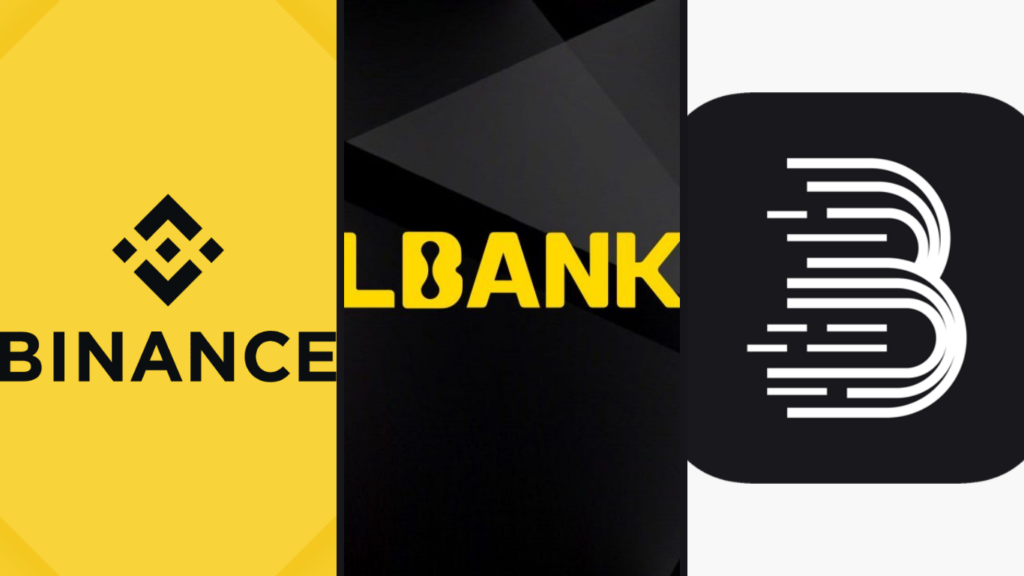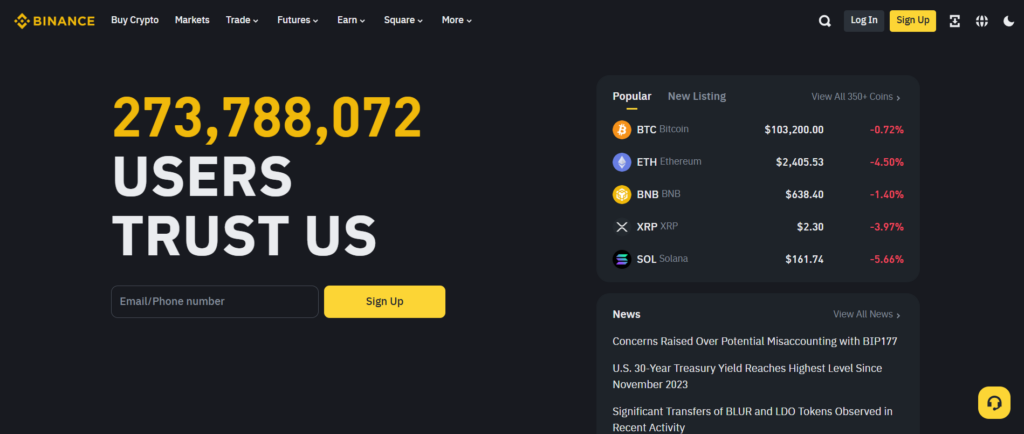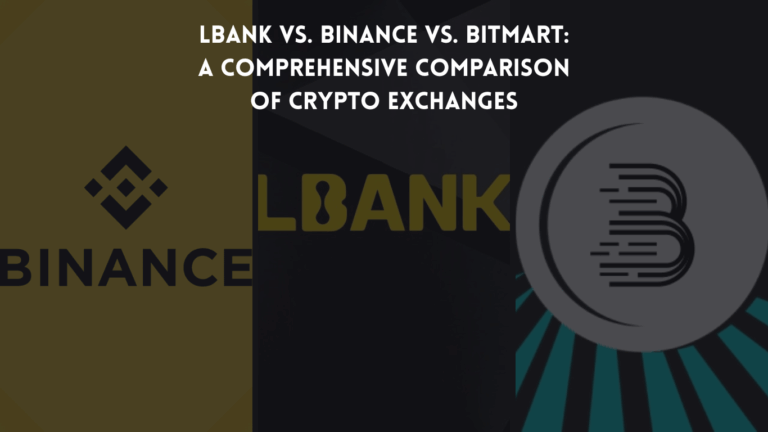In 2025, the cryptocurrency market thrives, with Bitcoin surpassing $100,000 and altcoins gaining traction. Choosing the right exchange is crucial for traders and investors. LBank, Binance, and BitMart are leading centralised exchanges (CEXs), each with unique strengths. This article compares them across fees, assets, security, usability, and more to help you pick the best platform for your crypto goals, whether you’re a beginner or a seasoned trader.
Overview of Each Crypto Exchange

Binance
Founded in 2017 by Changpeng Zhao and Yi He, Binance is the world’s largest exchange by trading volume, serving 240 million users in 180+ countries. It supports 350+ cryptocurrencies and offers an ecosystem including Binance Exchange, Trust Wallet, Launchpad, Labs, and a Web3 Wallet for DeFi and dApps. Its dominance is unmatched, but regulatory hurdles persist.
LBank
Established in 2015 in the British Virgin Islands, LBank serves 12 million users in 210+ countries. It supports 131+ fiat currencies via 55+ payment methods, emphasising spot, margin, futures, and leveraged ETF trading. LBank focuses on major coins like BTC and ETH, plus niche tokens like MEME, and is known for low fees and compliance.
BitMart
Launched in 2017 in the Cayman Islands, BitMart offers 1000+ trading pairs and a beginner-friendly platform. It supports spot, futures, staking, copy trading, and an NFT marketplace, with Web3 integration bridging centralised and decentralised finance. BitMart appeals to users seeking simplicity and modern features.
Also Read: Best VPNs for Crypto Trading
Key Comparison Metrics
Trading Fees: Balancing Cost and Value


- Binance: Tiered fees start at 0.10% for spot trading, with zero-fee BTC and ETH/BUSD pairs. Futures fees are 0.02% (maker) and 0.04% (taker), competitive for high-volume traders.
- LBank: Low fees at 0.02% (maker) and 0.04% (taker) for spot, with futures as low as 0.01% (maker), ideal for cost-conscious traders.
- BitMart: Spot fees are 0.25%, reducible with BMX tokens. Futures fees are competitive but higher than Binance and LBank.
Binance leads for affordability, LBank is close, and BitMart suits casual traders.
Also Read: Choosing secure platforms for cryptocurrency investments
Supported Assets and Trading Pairs: Variety Meets Liquidity
- Binance: 350+ cryptocurrencies, thousands of pairs, offering top liquidity for BTC, ETH, SOL, and more.
- LBank: Focuses on major coins and select altcoins like MEME, with fewer pairs but strong futures support.
- BitMart: 1000+ pairs, including niche tokens, though liquidity lags for some markets.
Binance excels in variety, BitMart offers diversity, and LBank prioritizes key assets.
Also Read: 9 Best Tools for Blockchain Analytics
Security Measures: Safeguarding Your Funds


- Binance: A $1 billion SAFU fund, strict KYC, and encryption. A 2019 hack (7,000 BTC) was fully reimbursed.
- LBank: NFA and MSB licenses, secure infrastructure, and no major hacks reported.
- BitMart: Advanced risk controls and wallet integrations. A 2021 hack ($196M) was reimbursed, with security since strengthened.
Binance and LBank edge out BitMart due to the latter’s past breach.
Also Read: How to Avoid Scams in the Crypto Industry?
User Experience and Accessibility: Ease of Use Matters
- Binance: Feature-rich but complex, overwhelming for beginners.
- LBank: Streamlined interface, 55+ payment methods, and fiat support enhance accessibility.
- BitMart: Beginner-friendly with copy trading and Web3/NFT features, highly rated for usability.
BitMart leads for novices, LBank balances simplicity, and Binance suits pros.
Also Read: Best AI Tools for Students
Additional Features: Beyond Basic Trading
- Binance: Staking, margin (10x leverage), futures, options, Web3 Wallet, and Launchpad.
- LBank: Leveraged ETFs (3x), grid trading, staking, and futures (125x leverage).
- BitMart: Staking, copy trading, futures, NFT marketplace, and Web3 integration.
Binance’s ecosystem is the broadest, LBank excels in futures, and BitMart bridges CEX/DEX.
Also Read: Best AI Tools For Animation
Regulatory Compliance and Restrictions


- Binance: Faces bans (e.g., UK 2021) and U.S. scrutiny, with Binance.US for Americans.
- LBank: Licensed in the U.S., Canada, and Italy, with fewer restrictions.
- BitMart: Compliant globally, with some U.S. limits but broad accessibility.
LBank and BitMart offer wider access than Binance.
Also Read: Best Crypto Trading Signals in India
Pros and Cons of Each Crypto Exchange
Binance


- Pros:
- Unmatched Liquidity: Highest trading volume ensures tight spreads and fast execution.
- Vast Ecosystem: Staking, futures, DeFi wallet, Launchpad, and more cater to all users.
- Low/Zero Fees: 0.10% spot fees and zero-fee pairs maximize profitability.
- Asset Variety: 350+ cryptocurrencies cover mainstream and niche markets.
- Global Reach: 240M+ users across 180+ countries, with multilingual support.
- Innovation Leader: Web3 Wallet and Launchpad drive blockchain adoption.
- Cons:
- Regulatory Challenges: Bans in regions like the UK and U.S. investigations limit access.
- Complex Interface: Overwhelming for beginners, with a steep learning curve.
- Customer Support Issues: Slow response times reported by some users.
- Past Hack Concerns: 2019 breach, though reimbursed, raises trust questions.
- Geographic Restrictions: Unavailable in some countries due to compliance issues.
Also Read: Best AI Affiliate Programs To Join
LBank


- Pros:
- Low Trading Fees: 0.02% maker fees for spot and 0.01% for futures are highly competitive.
- Fiat Flexibility: Supports 131+ fiat currencies and 55+ payment methods.
- Futures and ETFs: Up to 125x leverage and 3x leveraged ETFs for advanced traders.
- Regulatory Compliance: NFA and MSB licenses ensure trust and global access.
- No Major Hacks: Clean security record enhances reliability.
- Streamlined Interface: Simple design suits traders of all levels.
- Global Availability: Operates in 210+ countries with minimal restrictions.
- Cons:
- Smaller User Base: 12M users vs. Binance’s 240M limits network effects.
- Fewer Trading Pairs: Less variety than Binance or BitMart for niche tokens.
- Lower Brand Recognition: Less known globally, impacting trust for some.
- Limited Ecosystem: Fewer features like DeFi or NFT marketplaces compared to competitors.
- Customer Support Gaps: Occasional delays are reported in resolving complex issues.
Also Read: 7 Best FREE AI Chatbots That Will Blow Your Mind
BitMart


- Pros:
- User-Friendly Design: Intuitive interface ideal for beginners.
- Diverse Trading Pairs: 1000+ pairs, including niche tokens, offer ample choice.
- Web3 and NFT Focus: NFT marketplace and DeFi integration appeal to modern users.
- Copy Trading: Allows novices to follow expert strategies.
- Global Accessibility: Compliant in most regions with broad reach.
- Staking Options: Earn passive income on popular coins.
- Mobile App Quality: Highly rated for seamless trading on the go.
- Cons:
- Higher Fees: 0.25% spot fees are less competitive than Binance or LBank.
- Lower Liquidity: Some pairs have wider spreads, slowing execution.
- Past Security Breach: 2021 hack ($196M) may deter cautious users, despite reimbursement.
- Fewer Advanced Tools: Limited leverage and futures options for pros.
- Smaller Ecosystem: Lags behind Binance in feature breadth.
- U.S. Restrictions: Some features unavailable for American users.
Also Read: Top 5 Open-Source Trading Bots on GitHub
Which Crypto Exchange Is Right for You?
- Beginners: BitMart’s simplicity, copy trading, and NFT marketplace suit new traders.
- Advanced Traders: Binance’s liquidity, 10x leverage, and futures are ideal for pros.
- Fiat-Focused Users: LBank’s 131+ fiat currencies and 55+ payment methods excel.
- DeFi/NFT Enthusiasts: BitMart and Binance offer Web3 features, with Binance’s ecosystem being broader.
Consider fees, assets, and regional access. Futures traders may prefer LBank, while DeFi users might choose Binance.
Also Read: Chatbase Review: Build AI chatbots without coding
Conclusion
Binance, LBank, and BitMart cater to distinct crypto audiences. Binance leads with liquidity and features, LBank shines in fiat support and futures, and BitMart excels in usability and Web3 innovation. Align your choice with your priorities—cost, variety, or compliance. Stay updated on exchange developments and regulations to optimise your trading as crypto evolves. Explore these platforms and find your crypto home in 2025.
Frequently Asked Questions (FAQs)
Which exchange offers the lowest trading fees among LBank, Binance, and BitMart?
Binance typically offers the lowest fees, with spot trading at 0.10% and zero-fee pairs like BTC/BUSD, making it a cost-effective exchange. LBank follows closely with 0.02% maker fees for spot and 0.01% for futures, ideal for high-volume traders. BitMart’s 0.25% spot fees are higher but can be reduced with BMX tokens, suiting casual users of this exchange.
How secure is my money on these cryptocurrency exchanges?
Each exchange prioritises security. Binance maintains a $1 billion SAFU fund and strict KYC, despite a 2019 hack (reimbursed). LBank, with no major hacks, holds NFA and MSB licenses for a secure exchange environment. BitMart faced a 2021 hack ($196M, reimbursed) but now uses advanced risk controls, ensuring safety across these exchanges.
Can beginners easily use LBank, Binance, or BitMart as their first exchange?
BitMart is the most beginner-friendly exchange, with an intuitive interface and copy trading for novices. LBank’s streamlined design suits new traders but has fewer guides. Binance, while feature-rich, can overwhelm beginners due to its complex exchange platform, making BitMart the top choice for first-timers.
Which exchange supports the most cryptocurrencies for trading?
Binance leads as an exchange with 350+ cryptocurrencies and thousands of pairs, offering unmatched variety. BitMart supports 1000+ pairs, including niche tokens, but has lower liquidity. LBank focuses on major coins like BTC and ETH, with fewer pairs, making Binance the go-to exchange for asset diversity.
Are these exchanges available worldwide, or are there regional restrictions?
LBank and BitMart are widely accessible exchanges, with LBank operating in 210+ countries and BitMart compliant globally, though with some U.S. limits. Binance faces restrictions in regions like the UK and operates a separate Binance.US exchange for Americans, so check your region’s availability before choosing an exchange.


